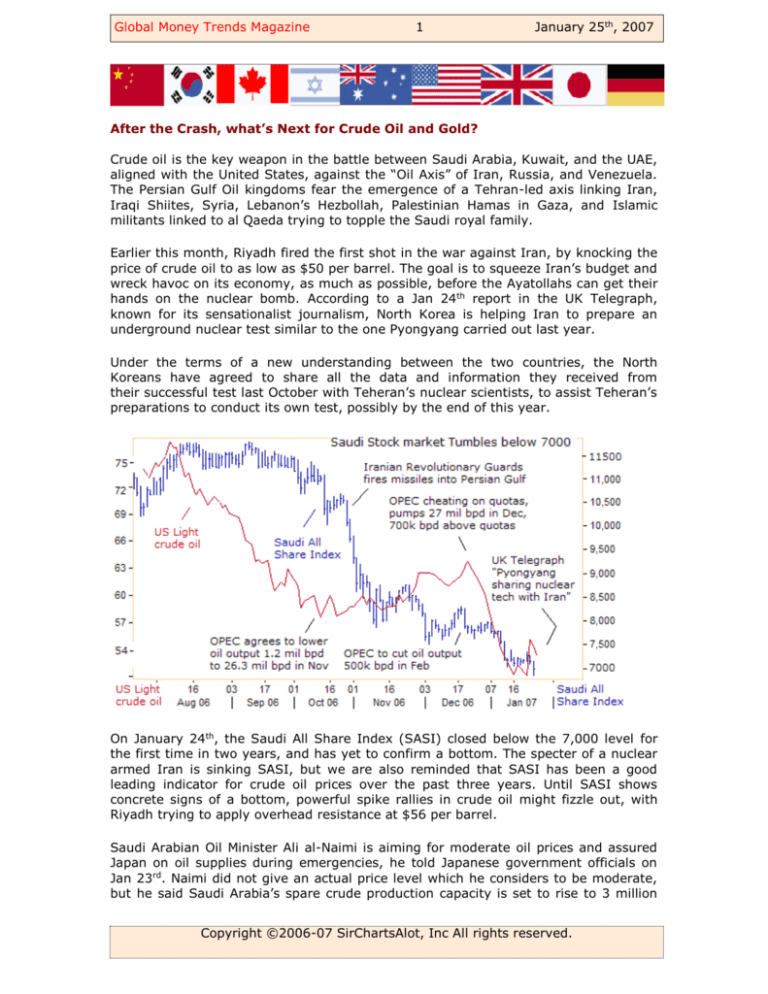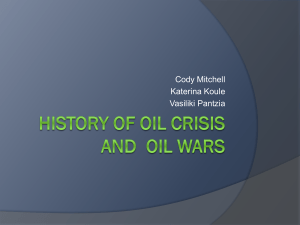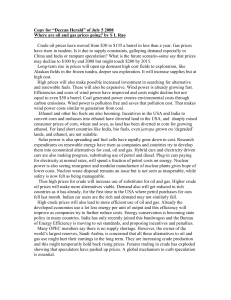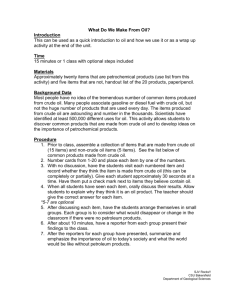
Global Money Trends Magazine
ecem
1
January 25th, 2007
After the Crash, what’s Next for Crude Oil and Gold?
Crude oil is the key weapon in the battle between Saudi Arabia, Kuwait, and the UAE,
aligned with the United States, against the “Oil Axis” of Iran, Russia, and Venezuela.
The Persian Gulf Oil kingdoms fear the emergence of a Tehran-led axis linking Iran,
Iraqi Shiites, Syria, Lebanon’s Hezbollah, Palestinian Hamas in Gaza, and Islamic
militants linked to al Qaeda trying to topple the Saudi royal family.
Earlier this month, Riyadh fired the first shot in the war against Iran, by knocking the
price of crude oil to as low as $50 per barrel. The goal is to squeeze Iran’s budget and
wreck havoc on its economy, as much as possible, before the Ayatollahs can get their
hands on the nuclear bomb. According to a Jan 24th report in the UK Telegraph,
known for its sensationalist journalism, North Korea is helping Iran to prepare an
underground nuclear test similar to the one Pyongyang carried out last year.
Under the terms of a new understanding between the two countries, the North
Koreans have agreed to share all the data and information they received from
their successful test last October with Teheran’s nuclear scientists, to assist Teheran’s
preparations to conduct its own test, possibly by the end of this year.
On January 24th, the Saudi All Share Index (SASI) closed below the 7,000 level for
the first time in two years, and has yet to confirm a bottom. The specter of a nuclear
armed Iran is sinking SASI, but we are also reminded that SASI has been a good
leading indicator for crude oil prices over the past three years. Until SASI shows
concrete signs of a bottom, powerful spike rallies in crude oil might fizzle out, with
Riyadh trying to apply overhead resistance at $56 per barrel.
Saudi Arabian Oil Minister Ali al-Naimi is aiming for moderate oil prices and assured
Japan on oil supplies during emergencies, he told Japanese government officials on
Jan 23rd. Naimi did not give an actual price level which he considers to be moderate,
but he said Saudi Arabia’s spare crude production capacity is set to rise to 3 million
Copyright ©2006-07 SirChartsAlot, Inc All rights reserved.
Global Money Trends Magazine
ecem
2
January 25th, 2007
barrels per day (bpd) in February. In the event of an embargo on Iran’s daily exports
of 2.4 mil bpd, Riyadh could fill the gap from its spare capacity.
To counter the Saudi inspired plunge in oil prices, Iranian President Mahmoud
Ahmadinejad proposed on Jan 21st, to cut the oil price on which the next Iranian
budget is based to $33.70 per barrel for the year starting in March, compared with
what he said was a price of $44.10 for the existing budget. “It is a signal to Iran’s
enemies saying we are ready and we will manage the country even if you lower the
oil prices more. We assume our enemies want to damage us by decreasing the
price of oil. So we must reduce our dependency on oil revenue,” Ahmadinejad said.
Iranian crude usually sells for about $7 a barrel less than US crude oil, so the
drop in crude oil to $52 per barrel for WTI in New York last week, would wipe out
Iran’s budget surplus. Any further drop in world oil prices would force Tehran to dip
into its foreign exchange reserves or seek loans from Beijing and the Kremlin, its
stalwart allies, in order to maintain vital subsidies for its population.
Tehran spends $20 billion to $30 billion on heating oil and gasoline subsidies per
year, costing the government roughly 15% of Iran’s GDP. Ahmadinejad was elected
promising to bring oil revenues to every family, eradicate poverty and tackle
unemployment. But he has failed to meet those promises. Anticipating a possible US
blockade of gasoline imports, Tehran will start rationing gasoline as of March 21 st.
The US Treasury has barred Iranian institutions from the US banking system,
effectively cutting Iranian banks off from foreign exchange transactions in US dollars,
which require a US counterparty bank. Because of US sanctions, Iran is looking to
China and Russia to help develop its resources, and in exchange has promised to
coordinate with Russia in marketing its natural gas to ensure that it does not loosen
Russia’s stranglehold over European markets.
Tehran believes this strategy think will get them out of the box that the Saudis and
the US are attempting to construct. China’s national oil companies have secured $100
billion of agreements to develop Iran’s huge oil and gas reserves.
The Specter of War hovers over the Middle East, Mohsen Rezai, secretary of
Iran’s Expediency Council, told the Dubai-based Al-Bayan newspaper on Jan 21st,
Copyright ©2006-07 SirChartsAlot, Inc All rights reserved.
Global Money Trends Magazine
ecem
3
January 25th, 2007
“America will exploit sanctions against Iran to incite people to rise up against the
Islamic revolution, provide aid to movements hostile to Iran, carry out operations
inside Iran and promote a sectarian war. The next two months will show the world
this strategy. An Iranian-US confrontation is inevitable,” he said.
Rezai would not rule out US missile strikes against Iran’s nuclear installations. Ali
Larijani, Iran’s top nuclear negotiator, said in remarks on Jan 20 th that Iranian armed
forces were ready to face any threat to its nuclear installations, amid speculation
Washington may be planning a military strike.
Saber rattling by Iranians officials to the media, and test firing missiles in the Persian
Gulf, are ultimately designed to raise the tension level in the world oil markets.
Recognizing the high risk strategy of taking on Tehran thru economic means, jittery
Saudi princes have been moving money from their local stock market into gold,
British pounds, and US Treasury notes. The net result has been a 25% gold rally
against the price of crude oil since Dec 15th, to a 3-year high of 12.2 barrels.
That’s significant, because it means that gold is shaking off its worries about a weaker
oil market. Still, lower oil prices should lower official G-7 inflation figures and confuse
potential gold converts. The relative strength of gold will present a major dilemma for
G-7 central bankers sometime in 2007, especially if bond markets begin to breakdown from explosive money supply growth and rising gold and silver prices.
Global Money Supply out of Control, While crude oil has a major impact on
inflation statistics churned out by governments, the gold market has shifted its
primary focus to explosive money supply growth that is pumping up global stock
markets. Central bankers have not raised their short term interest rates high enough
Copyright ©2006-07 SirChartsAlot, Inc All rights reserved.
Global Money Trends Magazine
ecem
4
January 25th, 2007
to slow down the global money supply, which according to the Economist magazine,
expanded an average 18% in 2006. In Japan, the central bank loan rate is absurdly
low at 0.25%, while the Swiss National Bank’s Libor target is only 2%.
“Markets show very strong risk appetite and risk premiums are very low,” said Swiss
National Bank Chairman Jean-Pierre Roth on January 24th, warning market volatility
would inevitably return, hurting investors. “My current thinking on the franc is that
this is part of the exuberance in the financial markets,” he said
Baby step rate hikes by central banks have failed to rein in explosive money growth.
In Australia, the M3 money supply is 13% higher from a year ago, British M4 is 13%
higher, the Euro zone’s M3 is 9.3% higher, a 16-year high, Korea’s M3 is 10.3%
higher, China’s M2 is 16.9% higher, India’s M3 is 20.5% higher, Russia’s M2 is 45%
higher, and the US M3 has been reconstructed to show 10.7% growth in 2006.
The great “paper
chase” is on, but would
an investor trying to
stay ahead of monetary
inflation be better off
putting
money
into
gold or a basket of Dow
Jones
Industrial
shares?
Both trading vehicles
are good choices to
stay
ahead
of
expanding M3 growth,
which is diluting the
purchasing power of
fiat currency
For the past three
and a half months, the
DJI to Gold ratio has
been locked in a tight
sideways
range
between 18.8 oz’s and
20.8 oz’s.
In fact, during the DJI’s last 1,000 point advance since September, Gold has also
moved higher at an equal pace, thus the DJI to Gold ratio at 19.4 oz’s, is unchanged
from four months ago. If this stalemate pattern continues, a further advance for the
DJI to the 13,000 level in the weeks ahead could also lift gold to as high as $675 per
ounce, while keeping the DJI /Gold ratio steady.
The recent sharp drop in crude oil prices to $55 per barrel leaves US consumers with
more money to spend, while they lower expenses for heavy fuel users, including big
manufacturers and Dow Transport companies. That’s positive news for US corporate
profit growth, which helped stocks put in a strong performance last year. Cheaper
fixed costs are welcome by corporate bond investors, too.
Lower oil prices can cushion the blow to an expected slowdown in S&P 500 profit
growth of 8.2% for the fourth quarter, after about four and a half years of straight
double-digit profit gains for S&P 500 companies, according to Standard & Poor’s.
Copyright ©2006-07 SirChartsAlot, Inc All rights reserved.
Global Money Trends Magazine
ecem
5
January 25th, 2007
So while Saudi Arabia
keeps oil prices low to
squeeze Tehran, Wall
Street power brokers can
drive the DJI higher,
even when S&P 500
profit growth is slowing.
But
what
would
happen if crude oil prices
suddenly surged above
$60 per barrel or much
higher due to fears of a
military explosion in the
Middle East?
In the event of a US
military strike on Iran’s
nuclear facilities and its
oil
refineries, or an
embargo on Iranian oil
exports, would gold or
the DJI be a better
investment?
The answer is elementary, so while the timing is uncertain, it pays to own Gold rather
than the DJI, because when the fateful day arrives, a military strike will be complete
surprise to Wall Street power brokers but not to gold bugs. In any case, one can still
argue, that in hard money term, the DJI is in a seven year bear market vs Gold,
highlighting the supreme importance of global liquidity and explosive money supply
growth in lifting the DJI and other stock markets higher around the world.
Gold Shines in Tokyo as BoJ Buckles Under pressure, Gold got a big boost last
week, when the Bank of Japan succumbed to heavy political pressure from the Shinzo
Abe government and voted 6-3 to leave its overnight loan rate unchanged at 0.25
percent. The BoJ is finding the radical inflationist Abe regime to be a much tougher
opponent to tighter money, than its predecessor regime under Junichiro Koizumi.
It’s doubtful that BoJ chief Toshiro Fukui could have drained 26 trillion yen from the
banking system with Abe in power. Moreover, political pressure from the Abe regime
to hold rates steady is not expected to abate and could even intensify ahead of an
election for parliament’s upper house in July. “We expect the BOJ to conduct
monetary policy appropriately while keeping in close contact with the government,”
said Chief Cabinet Secretary Yasuhisa Shiozaki on Jan 21st.
The final BoJ board vote was the closest in over three years and showed a marked
shift from the 9-0 vote at the last meeting when rates were also held steady. One of
the three hawks on the Bank of Japan Policy Board member Miyako Suda said on Jan
25th, the central bank needs to take certain risks in deciding monetary policy to
prevent excessive stimulative effects in the economy.
“Since we are guiding monetary policy in a forward-looking manner we need to take
certain risks, even if uncertainties remain in the outlook for the economy. Otherwise
the timing of a rate hike may be delayed," Suda said. Still, the hawks are out
numbered 2 to 1 at the BoJ, and the stench of dirty LDP politics hangs in the air.
Copyright ©2006-07 SirChartsAlot, Inc All rights reserved.
Global Money Trends Magazine
ecem
6
January 25th, 2007
After climbing to a 5-year high of 0.57%, Japan’s 3-month Libor rate plunged 14
basis points to 0.43% on January 25th, after the BoJ left its overnight rate unchanged
at 0.25%. Tokyo gold climbed 8% towards 78,800 yen /oz, just 3% shy of an 18-year
high. Tokyo gold traders have little faith in the BoJ to maintain the purchasing power
of the Japanese yen, which fell to 9-year lows against the British pound, the Euro,
and the Korean won, and down to a 4-year low against the US dollar.
From
a
strictly
technical point of view,
Tokyo gold has broken
out to the upside from a
perfectly
symmetrical
pennant
formation,
thanks
to
the
BoJ
buckling under heavy
political pressure.
Technicians
would
agree that the upside
measurement for Tokyo
gold is 94,000-yen /oz,
or 20% higher from its
current level of 78,000yen /oz.
That
implies
the
Japanese yen will remain
weak against the US
dollar and gold in the
weeks ahead, and any
BoJ rate hike would be
too little, too late.
However, Tokyo gold’s highest weekly close was 78,500-yen in 2006, which was also
its highest mark in July. Thus, the 78,500-yen level is the last remaining barrier
before signaling an all-clear for further big gains ahead. The US dollar did fall 1-yen to
120.50-yen on reports that European officials are furious with Tokyo’s cheap currency
policy, so a BoJ rate hike to 0.50% is possible in March. Still, in the grand schemes of
things, a 0.50% BoJ loan rate is not going to attract foreign investors to buy such a
manipulated currency, so GMT projects Tokyo Gold to hit 82,000-yen.
Copyright ©2006-07 SirChartsAlot, Inc All rights reserved.
Global Money Trends Magazine
ecem
7
January 25th, 2007
Gold Bumping against 500 Euros /oz, The European Central Bank is dragging its
heels in containing the explosive growth of the Euro M3 money supply, which
expanded at a 9.3% clip in December, it’s fastest in 16-years. The 14% decline in
crude oil prices in January is bound to exert downward pressure of European inflation
statistics, buying the ECB more time, before contemplating another rate hike.
The ECB kept its key rate at 3.50% this month, without giving any clear guidance on
the timing of its next likely move. “Lower oil prices could help ease Euro zone inflation
pressures in 2007 but upward risks still prevail,” said Bundesbank chief Axel Weber
on Jan 22nd. “There is potential for a slight relaxation in inflation for 2007, as long as
the oil price remains permanently at the current lower level,” he said.
“But I don’t think that is the most likely outcome when I look at the futures markets,
quite the opposite,” Weber noted. While the price of US light crude oil for February
delivery is trading at $51.20 per barrel, the farther dated June contract is quoted
above $55 /barrel. Still, the timing of Weber’s hawkish jawboning was designed to
turn back gold’s rally from the psychological 500 Euros /oz level.
For now, the ECB can offer nothing but verbal threats to restrain gold bulls in Europe,
who are squarely focused on the explosive M3 money supply growth. A surge in gold
above 500 Euros /oz would force the ECB’s hand, and make a quarter-point rate hike
to 3.75% all but inevitable. While not specifically mentioning the gold price, which is
foremost on his mind, Weber offers a diversion to explain his hawkish line.
“I fear that in the current economic environment, and given the political acceptance
that wage increases have found at the moment that wage settlements could turn out
stronger than we have assumed,” Weber said. German unions are seeking 5.5% more
pay for construction workers this year and up to 6.5% more in the engineering
industry, although official inflation in the Euro zone’s biggest economy was just 1.4%
in December. The gold market doesn’t place much faith in such statistics.
“Monetary policy cannot wait until second-round effects materialize. We have to run a
forward-looking monetary policy and orient ourselves based on what our expectations
are,” he said. According to the Frankfurt futures market, the ECB is expected to hike
its repo rate 0.25% to 3.75% in the first week of March.
Copyright ©2006-07 SirChartsAlot, Inc All rights reserved.
Global Money Trends Magazine
ecem
8
January 25th, 2007
The ECB is walking a
tight
rope,
between
growing political pressure
to halt its rate hike
campaign,
and
fears
about an upsurge in gold
prices above 500 Euros
/oz,
which
can
undermine the European
bond markets.
In the end, the ECB is
expected
to
continue
lifting its repo rate, but
at a slower pace than in
H’2 of 2006. But a slower
pace would make it more
difficult to rein in the
explosive growth of the
M3 money supply.
Six baby-step ECB rate hikes to 3.50% have kept gold locked within a range of 450 to
500 euros /oz for the past six months, or 14% below its 2006 high of 565 euros /oz.
European Gold bulls are waiting for the earliest signal that the ECB has run out of
ammunition on the monetary front, and is getting ready to join the Federal Reserve,
the Bank of Japan, and the Bank of Canada to sit on the sidelines.
The earliest date for the next ECB rate hike to 3.75%, which has a 140% probability
according to the Frankfurt Euribor futures market, is the first week of March, still six
weeks away. That’s a lifetime in today’s lightning fast financial markets. Six weeks
from now, GMT expects Gold to be 8% higher at 540 euros /oz, and an ECB rate
hike would simply be reactive to gold, rather than a pre-emptive move.
Gold
Ready
to
Rumble higher from
Down Under,
Gold is starting to
break-out in Sydney,
climbing
above
key
horizontal resistance at
630 Aussie dollars /oz
on Jan 25th.
More
importantly,
Gold is busting out of
an extended triangle
pattern,
which
is
typically a continuation
pattern of the previous
major trend, which is
obviously Upward!
Most interestingly,
Gold is up 10% since
the Bank of Australia’s
last rate hike to 6.25%
in November.
Copyright ©2006-07 SirChartsAlot, Inc All rights reserved.
Global Money Trends Magazine
ecem
9
January 25th, 2007
The new RBA chief Glenn Stevens wanted to prove his mettle as an anti-inflation
fighter, with a quick rate hike at the start his tenure. But in reality, Stevens has been
busy feeding strong loan demand at home, with explosive growth of the Aussie M3
money supply. It’s important to realize, that three RBA rate hikes to 6.25% last year,
did not slow down the growth rate of the M3 money supply.
Instead, Aussie M3 soared to a three and a half year high of 13% growth in
November, up from an annualized growth rate of 7.6% a year earlier. The RBA would
have to lift its cash rate another 75 basis points to 7.00% to get control over M3. For
now, the central bank is content to feed strong loan demand at home with injections
of cash, which has been pumping the ASX-200 Index to dizzying heights.
The ASX-200 Index has
doubled from four years
ago, while gold has gained
45% against the Australian
dollar.
There is more at work
behind the ASX’s strength
besides
rapid
money
supply growth. Booming
commodity
prices,
especially for base metals,
uranium and gold, boosted
Australia’s
mineral
and
energy exports to A$111
billion in 2006, up 20%
from the A$92 billion in
2005, lifting profits for
ASX-200 miners. Coal and
iron ore lead Australia’s
resource exports.
Copyright ©2006-07 SirChartsAlot, Inc All rights reserved.
Global Money Trends Magazine
2007
10
ecem
January 25th,
Will the RBA hike rates in the near future to contain the gold market? Probably not.
The Australian government has handcuffed the RBA for the next three months.
Canberra reported that the Australian consumer price index actually fell 0.1% in the
fourth quarter, the first drop since early 1999, linked to a huge 12% plunge in petrol
prices. The annual pace of consumer price inflation slowed to 3.3%, from 3.9% in the
third quarter and a peak of 4.0% in the second quarter.
On Jan 24th, Australian Prime Minister John Howard squashed speculation of another
RBA hike anytime soon. “This is a confidence boosting inflation number. It shows that
what appears to be a spike in Australia’s inflation rate may have disappeared. The
prospects are for a continuation of very moderate levels of inflation,” Howard said.
While the RBA is handcuffed by government statistics, GMT expects Sydney gold
traders to focus on the 13% M3 growth rate, and to bid gold 6% higher to
AD$880 /oz in the months ahead.
Gold Miners Under-valued, Have schizophrenic hedge fund traders out-smarted
themselves in the gold market? With gold bullion banging against key resistance at
$650 per ounce, and ready to climb to $675 /oz in line with an inflating Dow Jones
Industrials, the Gold Bugs Index (HUI) of un-hedged miners is 10% off its highs
reached in early December. Rarely do traders get such a slam dunk situation to buy
undervalued gold and silver mining shares, with gold racing higher.
While central bankers want to stay in the make-believe world of controlled
government statistics on inflation, gold is about to soar against a wide array of global
paper currencies. GMT’s minimum upside target for gold is $US675 /oz, but whatever
surprises the market might show, it could be to the upside with a surge to $US700
/oz, and above $AD680 /oz, 540 Euros /oz, and 82,000-yen /oz.
A global surge in gold and silver prices would certainly catch the attention of G-7
central bankers, but for the next few weeks, they are simply expected to confine their
protests to jawboning. Baby step rates hikes by the Bank of England, the ECB, and
the Swiss National Bank in March would only be reactive. If European officials blast
their Japanese counter-parts at the upcoming G-7 pow-wow in Germany next month,
then a Bank of Japan rate hike to 0.50% might also be in the cards.
Such measures might be too little, too late, and global bonds might start to tumble.
Copyright ©2006-07 SirChartsAlot, Inc All rights reserved.
Global Money Trends Magazine
2007
11
ecem
January 25th,
What about the outlook for Crude Oil? With renewed speculation of a US military
strike against Iran or an oil embargo in the air, GMT concludes that crude oil has hit
rock bottom at $50 per barrel. With crude oil trading above $55 /barrel today, such a
declaration is a several days too late, and several dollars too short.
I have written close to a thousand pages on the Iranian nuclear weapons program
over the past four years, and sounded like the boy who cried wolf, with predictions of
a military adventure falling flat and certainly out of sync with the latest slide in oil
prices since August. Will such speculation come into vogue again in the months
ahead? Timing is everything, and we must be psycho-analysts to figure out what on
the minds of crude oil or any other commodity and stock market.
Crude oil jumped $4 per barrel since the US Energy Department announced on Jan
23rd, a new push in the spring to fill the Strategic Petroleum Reserve with initial
purchases of 11 million barrels. “In the spring, that is to say about two months from
now, we will begin the fill. At current market prices we believe that we can purchase
about 11 million barrels of oil over the course of a few months, so that would be
approximately 100,000 barrels per day,” Energy secretary Bodman said.
The 100,000 barrels per day to be added to the SPR in late March or early April only
represents a 0.50% increase in daily US consumption, but was taken as a
psychological signal, that Washington thinks crude oil is near a bottom. From a
technical perspective, crude oil has stiff overhead resistance in the $56 /barrel area,
from the Neckline of a “Head and Shoulders Top” pattern, and more resistance from a
downward sloping trend-line which intersects around $58 per barrel.
Most H&S Top Patterns don’t reach their downside objectives, and usually end up as
bear traps. In other words, short-selling the crude oil market below $56 per barrel,
might only be the fuel for a short squeeze to higher prices later on, especially if
tension between the US and Iran heats up in the months ahead. Saudi attempts to
put a lid on oil, might only allow a crude oil rally to start from a lower starting point.
Furthermore, gold traders appear to be convinced that crude oil has bottomed out at
$50 per barrel and it’s only matter of time, until shorts are squeezed. Given the
enormous amount of global liquidity and super low interest rates in Japan and
Switzerland, hedge funds might become buyers of crude oil in the weeks ahead.
Copyright ©2006-07 SirChartsAlot, Inc All rights reserved.
Global Money Trends Magazine
2007
12
ecem
January 25th,
If correct, then traders looking for a bargain in a very richly valued stock market
might gravitate back to the Amex Oil Index (XOI) shares. There are two major
influences over the XOI shares, the trend of the broad market, (S&P 500) and the
direction of crude oil. Right now, the S&P 500 is racing to new 6-year highs, a bullish
factor for the XOI, while crude oil has bounced 10% of its lows from six days ago.
The energy sector represents 15% of total S&P 500 earnings. Exxon Mobil alone loses
about $540 million in earnings for every dollar the price of oil drops. Chevron and
Conoco Phillips, would lose about $330 million and $200 million, respectively, for
every dollar off the price of oil per barrel per year. But these companies are on strong
financial footing to weather the oil drop. GMT expects XOI to find support on
pullbacks to the 1140-level, and recover to the 1200 area.
Copper prices are stabilizing at $2.50 per pound, despite a jump in London stocks to a
3-year high of 203,000 tons today. China said it produced 2.93 million tons of copper
in 2006, up 17.8% from the previous year, partly explaining copper’s slide in the
second half of last year. GMT’s reading of a bearish triangle pattern for copper had
called for a drop to $2.40 pound. China is now expected to replenish badly depleted
stocks in Shanghai, after the Chinese New Year starts in February. China’s economy
grew by 10.7% last year, the fastest since 1995, providing support for copper.
Copyright ©2006-07 SirChartsAlot, Inc All rights reserved.
Global Money Trends Magazine
2007
13
ecem
January 25th,
Therefore, GMT suspects copper hit a major bottom at $2.50 /lb, and can
rebound to as high as $2.90 /lb in the weeks ahead, despite the stock build.
There are many moments in the life of a commodity trader, when raw emotions can
run rough shod over all reason or logic. Such was the case in London, where hedge
fund traders dumped zinc futures 24% off the all-time high of 4,600 per ton, in
reaction to a tiny rise in zinc stockpiles. Zinc is in a severe state of shortage, with
only 100,000 tons in LME warehouses, down from 740,000 tons in January 2004.
However, after wiping off the speculative froth, Zinc is stabilizing at $3,600 per ton,
enabling the world’s #1 zinc miner, Teck Cominco TCK.N, TCKb.TO, to rebound into
the middle of the previous $69 to $78 per share trading range. In highly volatile
markets, traders are tempted to gain quick profits by gunning stop loss orders in both
directions. Follow through sales in TCK.N evaporated near $66 per share, then
rebounded to $74 per share, in anticipation of a strong rebound in zinc.
The distortions of the global liquidity glut are also in play in metal miners and oil
companies, where share values are inflated relative to their underlying commodities.
Based on the current price of zinc at $3,600 per ton, TCK.N should be priced 10%
lower at $67 per share. The difference is speculative excess that comes along with
easy money. As for TCK.N, GMT prefers to buy on dips in the $69 to $72 range,
expecting a rally to $78 per share. Surprises would be to the upside. A short
squeeze in zinc to $5,000 per ton in 2007 cannot be ruled out yet.
Copyright ©2006-07 SirChartsAlot, Inc All rights reserved.
Global Money Trends Magazine
2007
14
ecem
January 25th,
Copyright © 2005-2007 SirChartsAlot, Inc. All rights reserved.
Disclaimer: SirChartsAlot.com’s analysis and insights are based upon data gathered by it from various
sources believed to be reliable, complete and accurate.
However, no guarantee is made by
SirChartsAlot.com as to the reliability, completeness and accuracy of the data so analyzed.
SirChartsAlot.com is in the business of gathering information, analyzing it and disseminating the analysis
for informational and educational purposes only. SirChartsAlot.com attempts to analyze trends, not make
recommendations. All statements and expressions are the opinion of SirChartsAlot.com and are not meant
to be investment advice or solicitation or recommendation to establish market positions. Our opinions are
subject to change without notice. SirChartsAlot.com strongly advises readers to conduct thorough research
relevant to decisions and verify facts from various independent sources.
Copyright ©2006-07 SirChartsAlot, Inc All rights reserved.
Global Money Trends Magazine
2007
15
ecem
January 25th,
Copyright ©2006-07 SirChartsAlot, Inc All rights reserved.








